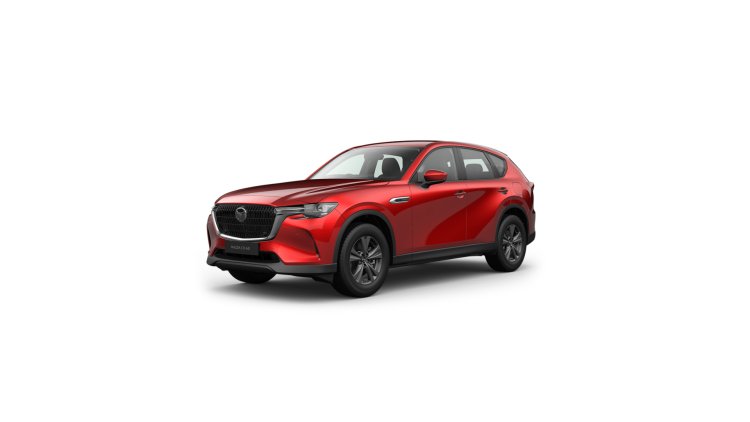CX-60: Mazda wants to return to high society

It is also Mazda's first fully hybrid model to bring plug-in technology.
The combination of 2.5-liter petrol and electric motor results in the total power of 241 kW / 327 hp and 500 Nm of torque, making this model the most powerful road vehicle Mazda has ever produced.
Mazda’s largest SUV model to date was the CX-5.
Its kind of replacement is coming soon, in the form of the CX-60, which wants to 'chew' a piece of cake like the VW Tiguan or the slightly more luxurious Audi Q5. The Japanese representative also has high hopes for a hybrid story.
This is the first of two SUV models, from Mazda's group of 'big models', which will arrive in the next two years. The CX-60 brings the latest in Kodo design, woven into the impressive solidity of an SUV with a longitudinally-mounted front-wheel-drive engine and rear-wheel drive. The front is dominated by a striking mask. There’s a new raised front grille, the distinctive Mazda wings with lighting function, and the design of vertically mounted headlights.
The novelty is also noticeable in the form of the new Rhodium white body color. In total, it will be possible to choose between eight body colors: Jet Black, Deep Crystal Blue, Sonic Silver, Platinum Quartz, Arctic White, Rhodium White, Machine Gray, and Soul Crystal Red. Wheels from 18 to 19 inches in diameter also support the strong impression.
The elegant interior design that brings a high level of quality is a mixture of different materials and textures.
So here we meet maple wood, Nappa leather, uniquely processed Japanese fabric, chrome details, and special detailed stitching on the instrument panel. The wide instrument panel has continuous lines that continue through the side air vents into the door trim, emphasizing the spaciousness of the interior.
Mazda emphasizes that the CX-60 delivers an ergonomically excellent, natural, and supportive driver position. Adjusting the height of the seat without changing the position of the body, provide correction of the height of the steering wheel by 4.5 centimeters and depth by 7 cm.
Man-centered technologies have been redesigned and refined to the new Jinba-Ittai driving experience and, more than ever, meet the individual needs of drivers. Mazda's driver personalization system recognizes the person in the driver's seat and automatically adjusts the environment - seat position, steering wheel, mirrors, head-up display, and even sound and air conditioning control settings - to suit the driver's physique and personal preferences.
The driver's personalization system of the new Mazda CX-60 contains three functions: automatic driver position setting; automatic reset and assistance in getting in and out of the vehicle. Automatic driver positioning uses a camera to detect the driver's eye position and enter the driver's height data to assess his physique, then automatically adjusts the seat, steering wheel, HUD, and exterior mirrors to suit the driver's eye position.
Automatic Reset uses face recognition and information on more than 250 settings and settings stored in the vehicle - including steering wheel position, sound settings, and air conditioning - to quickly and automatically restore settings for each individual when the driver changes. Furthermore, the entry and exit assistance function makes it easier for the driver to get in and out of the car by moving the steering wheel and seat so as not to interfere.
The white ambient lighting on the front and rear door trim best emphasize the color and texture of the interior finish. An additional option for the Mazda CX-60 mid-and upper-level versions is a large 106 cm x 99.5 cm panoramic sunroof to expand the range of visibility and light for rear-seat passengers. The roofline between the middle roof girders is designed to reduce weight and improve safety in side-on collisions.
The Human Machine Interface (HMI) has three main screens. These are a fully digital TFT-LCD instrument panel, a wide head-up display (HUD), and a 12.3-inch central display for information and entertainment. The head-up screen area is three times larger than that of the Mazda CX-30. This reduces unnecessary eye movements, provides the driver with the necessary information in an easy-to-understand way, and increases the feeling of safety while driving.
The latest version of Mazda Connect is also used. It includes enhancements such as faster startup, improved picture and sound quality, a built-in 3D gyro sensor, and a free word search feature that allows users to search for destinations by entering a combination of keywords. The system supports wireless Apple CarPlay and, for the first time at Mazda, wireless Android Auto as standard, to provide a hands-on user experience with smartphone integration.
Furthermore, the latest MyMazda app is available for free in the Apple App Store and Google Play Store. It is a connected services function for Europe with advanced functionality that removes all barriers between car and driver to create a seamless experience for owners. A number of practical and soothing features include the following: the Vehicle Find app helps the driver find a car if it is parked in a large car park.
When searching for a vehicle in a remote location that is not visible, it is possible to determine its position on the map screen. There is also a remote lock, but push notification when some of the doors on the vehicle are not closed. Maintenance-related information is available, such as tire pressure status. And owners can also be notified when regular service is scheduled.
Audiophiles have an improved version of the Harmonic Speaker System originally developed for the Mazda3. In case that’s not enough though, there’s also an audio system with twelve Bose speakers. It takes Bose BassMatch's engineering approach to the next level, providing a powerful listening experience with a deep, low-frequency effect for all passengers.
The CX-60 is 474.5 cm long, 189 cm wide, and 168 m high with a wheelbase of 287 cm, which gives enough space to all passengers, as well as ample luggage space. The cabin is wide enough and offers 150.4 cm of shoulder space in the front seats (4.4 cm more than the CX-5) and 144.1 cm in the rear seats (5 cm more than the CX-5). There is plenty of legroom in the rear seats for passengers to straighten their legs while sitting, instead of having to bend their lower body - even those with large bodies can maintain a comfortable and stable position while sitting.
Including space below floor level, the Mazda CX-60 has a boot capacity of 570 liters, which increases to 1148 liters with folded rear seats, or to 1726 liters if ceiling space is used. The usability of the luggage space has been greatly improved compared to that of the CX-5. The width of the boot opening has been increased to 108.2 cm (3.5 cm wider than the opening on the CX-5), and the opening height is 75.8 cm.
Also, the height difference between the cargo area floor and the boot sill has been reduced for easier loading. Irregularities in the walls have also been removed to ensure a flatter shape of the luggage compartment. The luggage compartment is equipped with a 12 V DC socket (optional 1500 W AC option for the e-Skyactiv PHEV with tire repair kit). The Mazda CX-60 can also be equipped with an electric tailgate with the option of hands-free use.
The Mazda CX-60 will be available with four equipment packages: the basic Prime-line package, the Exclusive-line middle package, and the richer equipment and top-quality Takumi and Homura packages. They will be somewhat different visually, but let's leave something for the fall when this model should be available in domestic showrooms.
Mazda aims to electrify all vehicles by 2030. Accordingly, the CX-60 will not only bring its first PHEV but will also offer 48 V Mazda M Hybrid Boost technology. It was created on an adaptable Skyactiv platform capable of multiple solutions of longitudinally mounted engines. This allows further electrification advances and environmental requirements to be met with the newly developed six-cylinder in-line petrol and diesel in-line engines, as well as Mazda vehicles with M Hybrid Boost and PHEV technology.
The longitudinally-mounted drive format of the Mazda CX-60 offers many benefits. These include the ability to mount motors and batteries of different sizes in the same layout for Mazda M Hybrid Boost and PHEV versions, as well as space for mounting electric motors on the same axis as the engine and transmission. The Mazda CX-60's powertrain range consists of three new engines. Most importantly, it is the first PHEV, which consists of a 2.5-liter four-cylinder petrol engine e-Skyactiv-G with electrification technology. There are also two in-line six-cylinder engines: the 3.3-liter e-Skyactiv-D diesel engine and the 3.0-liter e-Skyactiv-X petrol engine.
All three powertrains are mated to a new eight-speed automatic transmission and i-Activ all-wheel-drive system. Diesel e-Skyactiv-D and petrol e-Skyactiv-X are also available with rear-wheel drive only. Mazda's Mi-Drive system offers four driving modes (plus EV mode for PHEV) to ensure optimal control and driving pleasure in every driving scenario.
Six-cylinder engines have been developed based on the 'right size' concept, which means optimal displacement in order to improve efficiency and reduce fuel consumption at the required power. Combining an eight-speed automatic transmission with the electrification of the slightly hybrid 48 V, M Hybrid Boost system, all three engines are designed to improve power delivery and driving pleasure while improving environmental performance.
Mazda's first PHEV powertrain is a combination of a modified version of the Skyactiv-G 2.5 engine, a four-cylinder, direct-injection petrol engine in the CX-5 with a large 100 kW electric motor and 355V, 17.8 kWh lithium-ion battery. The petrol engine develops a maximum power output of 141 kW at 6000 rpm and a torque of 261 Nm.
The electric motor achieves 100 kW of power and torque of 250 Nm at zero rpm. With adjustable suction to improve torque in the most commonly used ranges of medium and low operating modes - 1500 to 3000 rpm, this engine combination delivers a total output of 327 hp / 241 kW and powerful torque of 500 Nm, which makes this model the most powerful a road vehicle Mazda has ever produced.
The Mazda CX-60 e-Skyactiv PHEV delivers very enviable performance. There is an acceleration of 0 - 100 km / h in 5.8 seconds and a limited top speed of 200 km / h. On the other hand, while working only on an electric motor, PHEV shows excellent environmental characteristics. WLTP combined fuel consumption is only 1.5 l / 100 km, and WLTP combined CO2 emissions only 33 g / km. The Mazda CX-60 e-Skyactiv PHEV allows 63 km of electric-only driving while the vehicle travels at speeds of up to 100 km / h.
The petrol offering consists of an in-line 3.0-liter six-cylinder e-Skyactiv-X engine. The larger displacement allows more air to be sucked into the engine, eliminating the need for turbocharging. This allowed Mazda to create a powertrain of simple basic structure with two camshafts in the head and variable valve timing that reliably and instantaneously changes the camshaft phase. Thanks to this, the internal exhaust gas recirculation (EGR) control achieves combustion with an extremely lean mixture.
For diesel lovers, there is a regular six-cylinder diesel engine. The working volume has been increased from 2.2 to 3.3 liters, as well as an increase in the range of operating modes in which it is possible to burn a lean mixture (high-efficiency combustion with minimal fuel consumption). In addition to improving end performance thanks to increased engine capacity, Mazda has designed the unit to use excess air to improve combustion. The result is a faster response to acceleration, lower NOx emissions at high speeds and higher loads, and better thermal efficiency thanks to a wider range of modes in which lean mixture combustion is possible.
For the first time, both Mazda six-cylinder in-line powertrains in the CX-60 are equipped with MHEV 48V hybrid technology. When paired with a diesel engine, it not only gives better fuel consumption values but also improved environmental performance by using electric motors to support the engine at light load ranges (idling or low speeds) where internal combustion engines are not overly efficient.
Mazda has developed the Mi-Drive Intelligent Drive Selection System for the CX-60, which offers five variable driving modes - Normal, Sport, Off-Road, Towing, and EV (PHEV only) - to optimize traction, friction, performance, handling, and safety in the widest range.
The Mazda CX-60 introduces some new technologies for the first time: a new-generation view through the vehicle with a 360-degree display with extended field of view at low speeds; Downhill Driving Control (HDC), which helps when descending steep slopes on slippery or uneven surfaces; cruise control (i-ACC), which now includes speed limits from the traffic sign recognition option and a vehicle exit warning (BSM) that detects vehicles, pedestrians and cyclists approaching from the rear of the vehicle.





























